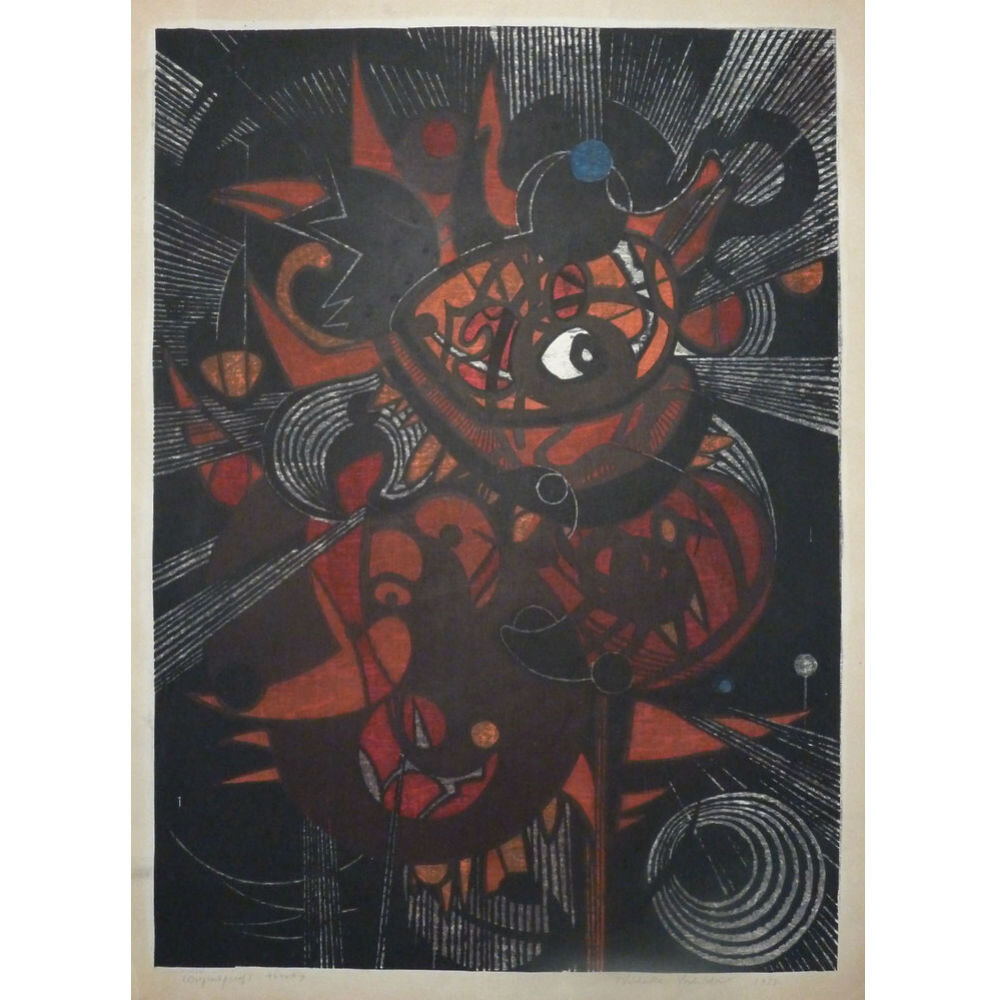吉田穂高 HODAKA YOSHIDA (1926-1995)
Hodaka Yoshida was born into the Yoshida house; a family which today embodies creative excellence over four generations of artists & printmakers - and is a name within Japanese cultural arts which arguably symbolizes a single-family art movement in its own right.
Establishing a career defined by significant artistic autonomy and independence, Hodaka’s works were a stark contrast to those of his brother Toshi Yoshida who naturally adopted a style & methodology alike to that of his father’s renowned Yoshida studio. Reflecting distinct phases of approach inspired by travel and the exposure to new cultures and foreign art, Hodaka Yoshida’s prints evolve with an exploration of colour, subject matter, and design methods. Hodaka further printed with silkscreen, lithograph, etching, and photographic mediums alongside his woodblock works.
Artist Biography:
Tokyo, 3rd September 1926, Hodaka Yoshida was born to Hiroshi Yoshida (1876-1950) - one of Japan’s greatest 20th Century Western-style shin-hanga artists - and Fujio Yoshida (1887-1987). The younger of two siblings, and with a birth name attributed to his father’s love for one of Nagano prefecture’s most spectacular sights, Mount Hodaka, Yoshida and his brother (Tōshi Yoshida (1911-1995)) entered into a life of particular artistic opportunity - much like many successful contemporaries of their time.
One would expect, that as tradition defined, both Hodaka and Tōshi would naturally apprentice into the Yoshida house of printmaking; learning & mastering the rich array of artistic technique, colour and style attributed to the name. However, despite offering this opportunity to his eldest son, Hiroshi Yoshida encouraged Hodaka to pursue an alternative career in science. Graduating from one of Japan’s most prominent schools, Hodaka’s studies had still required an additional two years to complete; the always alluring attraction toward the arts driving an independent exploration of poetry & abstract oils alongside his studies in biology.
During this period however - with the Second World War in the pacific concluding, artists whom once felt bound to produce works in-line with traditional practices, (perhaps due to a sense of underlying nationalism), now felt a huge sense of freedom to explore other mediums and art styles. The once government controlled, pre-war art establishment had now collapsed. New independent and private exhibitors were emerging across Japan offering artists the chance to break away from its nation's shadowed past and artists such as Hodaka now had the opportunity to explore new foreign art movements gripping Europe and the Americas at the time. Hodaka had already grown up with an early admiration for the famous iconography and abstract works of European artists Joan Miro (1893-1983) and Paul Klee (1879-1940), and now, this new seismic shift in social reform and creative optimism served as a perfect catalyst to empower Hodaka to commit to, & fully pursue his career as a painter & print-maker.
By 1950, Hodaka had since met Chizuko Yoshida (1924-) - whom he married in 1953 - and was carving & printing his own woodblocks. An artist herself, Chizuko had returned to Tokyo following evacuation to Aomori during the war, and had quickly proceeded to exhibit her own oils for the Pacific Painting Association (Taiheiyō-Gakai). A society established in 1902 by Hiroshi Yoshida, and naturally where Hodaka and Chizuko met; they soon began to jointly display their pieces before seeking to exhibit and travel outside of Japan in the early 1950’s. Much like his father’s own passion for travel, Hodaka left for the Americas with Chizuko in the search of new inspiration and a desire to experience foreign culture. An important decision in both their lives; for Hodaka it signified the start of a period in his life to which his future success and renown as an international Japanese artist is now identified with today.
Yoshida produced over six-hundred prints whilst visiting and teaching his craft to those in more than thirty countries over the coming decades. Initially influenced by the indigenous people of Mexico; Hodaka’s early work took inspiration from early primitive art collections (New York 1950) and pre-columbian artifacts. Exploring their relevance and the symbolic nature they had toward modern culture and human attitudes, Hodaka’s work throughout the 1950’s & 60’s was built on a desire to express his understanding of the connection between humanity, nature, and primitive life. Furthermore, this period of Hodaka’s life coincided with his father’s (Hiroshi Yoshida’s) death, and despite printing abstractly, it is interesting to consider the significance of his passing upon Hodaka’s perspective, approach, and union of themes.
Hodaka’s printing transitioned through multiple phases as his knowledge of other art forms and cultures grew. Defined by unique colour palettes, subjects, and printing styles, Hodaka not only worked with woodblocks, but also silkscreen, lithograph, etching, and photographic mediums across expressionist, colour abstraction and pop design influences.
Eugene Skibbe - a leading collector and scholar of Hodaka’s work (www.hodakayoshidaprints.com) - identified nine particular periods/chapters to his work:
1950-53 Early Prints.
1953-54 Buddhist Prints.
1955-63 Primitive Prints.
1963-66 Folk Prints.
1966-74 Mythology and Landscape Prints.
1974-79 House and Nude Prints.
1979-84 FMC House Prints.
1984-91 Recollection Prints.
1991-95 Wall Prints.
Hodaka Yoshida developed a career defined by significant artistic autonomy and independence - a stark contrast to his brother Toshi Yoshida who naturally adopted the art style & influence of his father and the Yoshida studio. Whilst Toshi inherited the Yoshida studio after Hiroshi’s death, and so more directly continued the family’s legacy, Hodaka’s accomplished work further widened & strengthened the already renowned heritage of the Yoshida name. Both becoming a member of the Japan Artists' Association and later vice president to the International Artists' Association, Hodaka was undoubtedly respected and admired by his peers both in Japan and around the world.
Hodaka passed away in 1995, leaving his wife Chizuko, a daughter Ayomi Yoshida (1958-), and a son Takasuke (1959-).
Written by: Jack Payne | © Lambsquay Gallery
BIBLIOGRAPHY/ARTICLES:
Eugene & Margaret Skibbe. Collectors and scholars on Hodaka Yoshida. Founders of website www.hodakayoshidaprints.com.








